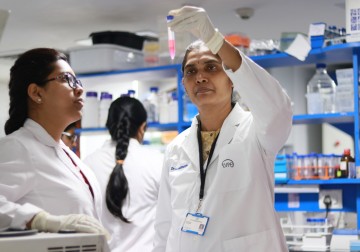In a new multi-institutional collaborative study, Drs. Sundaram Acharya, Debojyoti Chakraborty, and others have engineered Cas9 enzyme variants, which enhances the genome-editing precision of the CRISPR/Cas9 system, while Dr. Indumathi Mariappan and her team used it to correct a mutation in RPE65 gene in the cells of a patient with Leber congenital amaurosis, type 2 (LCA2).
The CRISPR/Cas9 system is a remarkable DNA editing technology which can be used to make changes at specific sites of a genome. Targeted gene editing can be used to diagnose/treat genetic disorders and model/study inherited eye diseases. The system uses a bacteria-derived DNA-slicing enzyme called Cas9, which has been modified to work on human, animal, or plant DNA. Cas9, often derived from the bacteria Streptococcus pyogenes (SpCas9), and shepherded by a guide RNA (gRNA), can make nucleotide insertions, deletions, and can even change individual nucleotide bases in a gene (base editing). However, SpCas9 is not always accurate and can slice genomic DNA outside the targeted site. Such ‘off-target’ editing can lead to more mutations and dire consequences. Scientists have engineered SpCas9 variants with improved accuracy, but it came at the cost of reduced gene editing efficiency.
Indian researchers found that Cas9 from the bacteria Francisella novicida (FnCas9) has a higher precision than SpCas9, leading to much lower off target editing. But native FnCas9 has poor editing efficiency. CRISPR requires a 20 bp long target DNA region that perfectly matches the gRNA and an adjacent three-nucleotide sequence called a protospacer adjacent motif (PAM) to perfectly recognize its target. If FnCas9 can be engineered to improve its efficiency and PAM targeting, it can become a superior alternative to SpCas9—especially for high-precision procedures like base editing.
In a new study published in the journal Nature Communications, Drs. Sundaram Acharya, Debojyoti Chakraborty, and others from CSIR-IGIB and other institutes engineered three enhanced FnCas9 (enFnCas9) variants with improved efficiency and flexible PAM requirements. The researchers modified the FnCas9 enzyme expanding the enzyme’s accessibility across human genomic sites by 3.5 times. The enFnCas9 variants were also able to accurately detect twice the amount of single nucleotide variants in a gene compared to FnCas9, expanding the range of genetic diseases that can be diagnosed using CRISPR. Longer gRNAs have more nucleotide bases complementary to the target gene, which makes Cas9 targeting more specific to a genetic sequence, lowering the risk of off-target editing. EnFnCas9 variants are compatible with ‘extended’ and ‘super-extended’ gRNAs, allowing for ultra-precise base editing.
To test enFnCas9’s precision, Dr. Indumathi Mariappan, and her team at LVPEI used the enzyme to correct a mutation in cells from a person with Leber congenital amaurosis, type 2 (LCA2), a rare genetic eye disease. In LCA2, a single nucleotide error in the RPE65 gene prevents its function in the retina in converting light into neural signals, thus leading to blindness. The researchers used induced pluripotent stem cells (iPSCs), generated from skin cells of a person with LCA2, which carried a mutation in the RPE65 gene. The enFnCas9-based CRISPR tool was then used to rectify the single nucleotide mutation in RPE65 in those cells. The mutation corrected iPSCs were used to make retinal pigmented epithelial (RPE) cells, which showed normal levels of RPE65 protein. This breakthrough research opens new avenues for CRISPR-mediated diagnosis, treatment, and modeling of various inherited genetic disorders.
‘The safety and applicability of any CRISPR-based system for therapeutics rely on their precision in target recognition, improved edit efficacy and off-target discrimination,’ explains Dr. Indumathi Mariappan, a research scientist at the Sudhakar and Sreekanth Ravi Stem Cell Biology Laboratory, LVPEI and an author of this paper. ‘The EnFnCas9-based editing tools offer better precision and open exciting possibilities for developing newer therapeutics and diagnostics for inherited diseases.’
Citations
Acharya, S., Ansari, A. H., Kumar Das, P., Hirano, S., Aich, M., Rauthan, R., Mahato, S., Maddileti, S., Sarkar, S., Kumar, M., Phutela, R., Gulati, S., Rahman, A., Goel, A., Afzal, C., Paul, D., Agrawal, T., Pulimamidi, V. K., Jalali, S., Nishimasu, H., … Chakraborty, D. (2024). PAM-flexible Engineered FnCas9 variants for robust and ultra-precise genome editing and diagnostics. Nature Communications, 15(1), 5471. https://doi.org/10.1038/s41467-024-49233-w
Photo credit: V Praveen Kumar.



